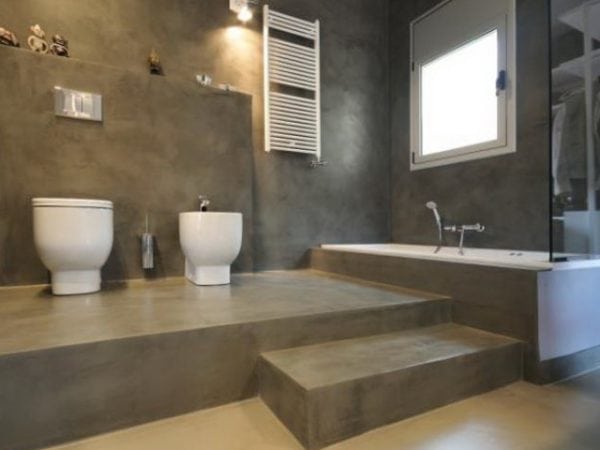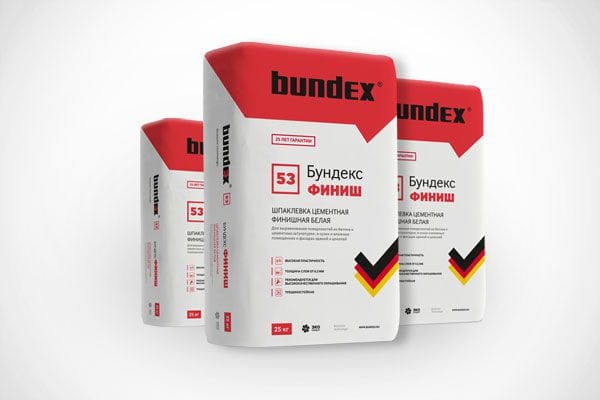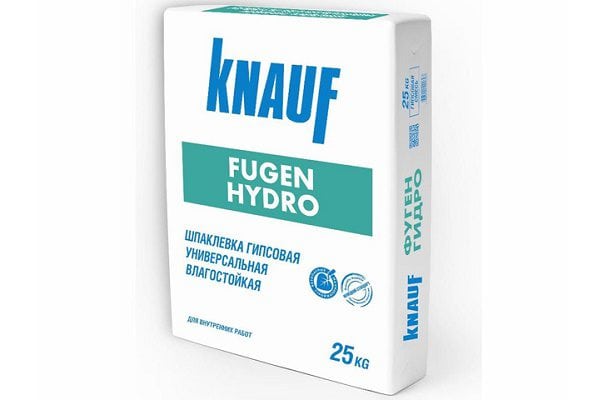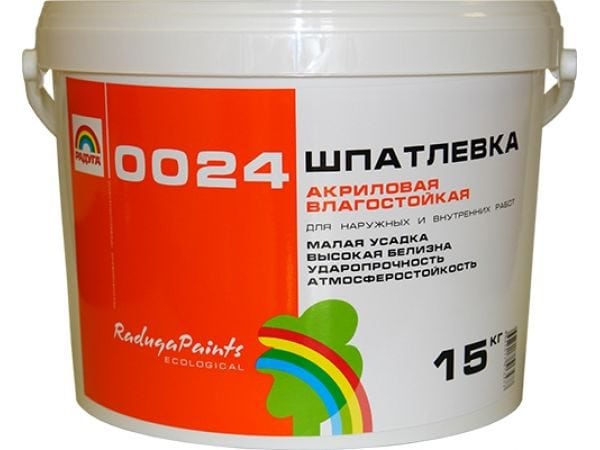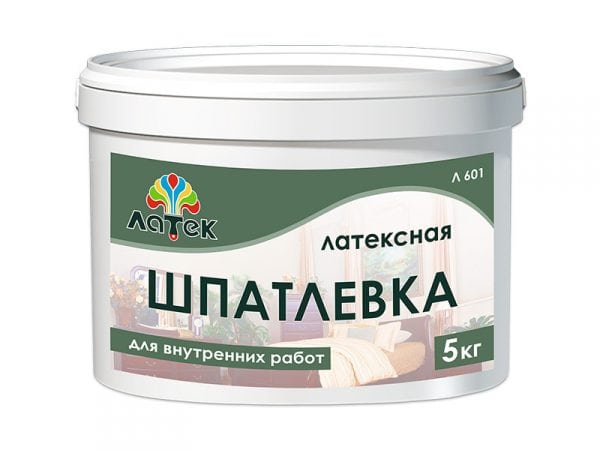Moisture-resistant putty is much more expensive than usual, and many beginning masters consider its acquisition an unnecessary waste of finance. But is such a saving always justified? Sometimes the desire to save a little leads to additional costs, because an unsuitable putty composition absorbs moisture, deforms, and the finish will lose its attractiveness.
- Importance of application
- How to choose a putty mixture
- Cement
- Gypsum
- Acrylic
- Latex
- Finishing Technology
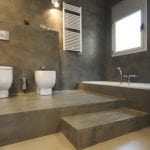
Importance of application
In the bathroom, in the kitchen or on the street, if you use the usual compounds for puttying, soon the following will happen:
- Putty absorbs moisture in the air and swells.
- The adhesion of the putty mixture with the base will become fragile.
- A loose connection to the base will cause the decorative finish to crack or peel.
Recently made repairs will no longer look perfect, and will have to be redone. And this is an additional financial cost.
to contents ↑How to choose a putty mixture
Which waterproof putty is better? How to choose a composition that will ensure the perfect appearance of the finish and will not absorb moisture? For this, it is worth considering the main components of moisture-resistant putty. The material is made from:
- cement;
- gypsum;
- acrylic;
- latex.
Cement
The main component of this mixture is Portland cement, in which polymer additives are added. It is sold in the form of a dry mixture, and before application to the surface it is diluted in the right proportion with water.
The diluted cement composition hardens very quickly, so a small amount of powder is recommended to be diluted simultaneously. A distinctive feature of the compositions for leveling walls with cement is that the higher the ambient humidity at the time of solidification, the stronger the connection. On the first day, in order to obtain increased strength, it is recommended to water the applied putty mass, and it is better to finish the facades on a rainy or foggy day. Another plus: any finishing material fits well on the cement base.
It is an ideal putty for wet rooms, pools and facades, but its cost is high. Those who wish to save money are advised to familiarize themselves with the features of other moisture-resistant mixtures and then determine what can be purchased for leveling the surface if the room is high in humidity.
to contents ↑Gypsum
For manufacturing, a gypsum-cement mixture is used. Gypsum putty has almost the same strength as cement, but only after full hardening. It is rarely used in the pool, but quite often for finishing facades, a bathroom or kitchen.
Gypsum putty for the bathroom or for the facade has one big minus: during the day after its application, until complete polymerization occurs, the surrounding atmosphere must be dry. This means that you will not be able to use the bathroom, and the street should have warm, dry weather. If this rule is not observed, it may happen that the gypsum absorbs excess moisture and adhesion to the leveling surface is broken. Gypsum putty is a little cheaper than cement.
to contents ↑Acrylic
Acrylic putties have proven themselves in various finishing works due to the following qualities:
- convenience in work;
- environmental cleanliness (do not contain toxic substances);
- low cost.
Manufacturers produce dry powder with acrylic and polymer components, which must be diluted with water before use, as indicated in the instructions. The composition is available as universal or for use, taking into account the type of base (additionally contains components protecting the material). So, anticorrosive components are added to the mixture for puttying the metal, and puttying on wood with acrylic will additionally protect the wood from fungus, insects or fire if it is spread with a thin layer over the entire surface of the wood.
Some home craftsmen prefer to make putty paste with acrylic on their own, using water-based acrylic varnish and gypsum powder. Gypsum is added to the varnish until a uniform consistency of medium viscosity is obtained and is quickly applied to the surface. According to the experts, the gypsum-acrylic mixture hardens quickly and provides strong adhesion to the wall. It is used for exterior and interior decoration before applying the topcoat.
to contents ↑Latex
The main advantage of latex is its ductility, which remains even after drying, so even flexible trim elements can be aligned with it. Putty with latex adheres well to the base and creates a beautiful matte or glossy film on the surface that retains its qualities for more than 10 years. It dries well, retaining its moisture resistant qualities even in conditions of high humidity. Various dyes fit well on the latex surface.
When working with latex, it is recommended not only to repair cracks and dents with it, but also to cover with a thin layer the entire area of the wall.
A disadvantage of latex putty is considered to be the ability to collapse under temperature extremes and under the influence of sunlight, therefore it is used only for internal work. Latex is widely used in the decoration of the kitchen or bathroom as an environmentally friendly and quick-drying material.
to contents ↑Having become acquainted with all the characteristics, you can decide which putty is most suitable for leveling the walls before decorative decoration.
Finishing Technology
How to work with moisture resistant putty? In the same way as with the usual, and it doesn’t matter on what basis it is made: gypsum, cement or latex. It is not necessary to immediately spread the putty powder, as indicated in the instructions, before using it, it is necessary to carry out several preparatory steps:
- Clean the wall. Traces of old finishes, dust and various contaminants are removed from the surface. For this, depending on the degree of pollution, a spatula or a metal brush is used. Some craftsmen prefer to use a grinding machine with the appropriate nozzle.
- To wash. Some masters neglect this step, especially when carrying out facade decoration, but washing more fully removes all contaminants. To wash facades or fences, it is recommended to use a portable car wash, and wash the walls in the rooms with a brush and a rag. It is very important to thoroughly rinse the used detergents with clean water, otherwise soapy components can impair adhesion when applying soil and puttying.
- To dry. Drying is not necessary only when using cement putty.
- Primer. Application of the primer will increase adhesion during puttying, and will make the joint stronger and more durable.
After the soil has dried, the base is ready, now you can dilute the putty powder, as indicated in the instructions. It is necessary to breed in a small amount, since the mixture quickly thickens.
It is necessary to putty the wall with a thin layer, applying the composition with a rubber spatula and evenly distributing it on the surface. If the cracks or dents are large, then you do not need to try to repair them immediately - it is better to wait for the applied solution to dry, primer again and repeat the alignment. The amount of putty applied during leveling is not limited. It is important only to apply each subsequent layer after drying the previous one and do not forget to use a primer.
It is a mistake to believe that the use of moisture-resistant putty mixtures is an unnecessary waste of money and you can get by with conventional formulations. After a couple of years in the kitchen or in the bathroom (on the facade this will happen during the year), the decorative finish is deformed and will lose its attractive appearance. It will require replacement. It is worth calculating the cost of moisture-resistant putty and the cost of premature repairs and concluding that it is more profitable to purchase.

